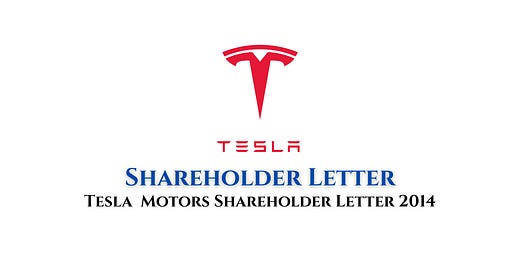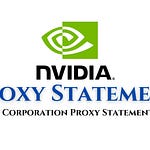Tesla Shareholder Briefing: 2014 Key Developments and Outlook
Sources: Tesla Motors, Inc. – First Quarter 2014 Shareholder Letter
Tesla Motors, Inc. – Second Quarter 2014 Shareholder Letter
Tesla Motors – Third Quarter 2014 Shareholder Letter
Tesla Motors – Fourth Quarter & Full Year 2014 Shareholder Letter
Executive Summary
Tesla experienced significant growth and strategic advancements throughout 2014, marked by expanding global demand for the Model S, increased production capabilities, and key product introductions like the Dual Motor Model S and Autopilot hardware. The company made substantial progress on its Gigafactory project and continued to strengthen its international presence. Despite some production challenges, Tesla anticipates continued strong growth in vehicle deliveries and gross margin expansion for 2015.
Key Themes and Most Important Ideas/Facts
1. Growing Global Demand and Market Expansion
Sequential Increase in Orders: Q1 2014 saw a "significant sequential increase in worldwide net orders for Model S," driven by a "greater global footprint and increasing consumer awareness." This trend continued, with Q2 Model S orders increasing "at a much faster rate than for the rest of the automotive industry" in North America and Europe.
China Entry & Success: Tesla's entry into China was "greeted enthusiastically," with initial deliveries in Beijing and Shanghai in Q1 2014. The Shanghai government's decision to offer "free license plates" (avoiding $10,000-$15,000 public auction prices) made the Model S value proposition "even more compelling." By Q3, the Shenzhen location became "one of our highest grossing stores worldwide."
Right Hand Drive (RHD) Markets: The addressable market expanded with the launch of RHD Model S in the UK (Q2), Hong Kong (Q2), and plans for Japan and Australia by year-end 2014. Hong Kong was noted as a "unique market because Model S is exempt from registration tax."
Customer Mileage & Fuel Savings: By Q1 2014, Model S owners had driven "more than 275 million miles, saving nearly 14 million gallons of gasoline." This increased to "394 million miles globally, saving nearly 18 million gallons of gasoline" by Q2.
2015 Demand Outlook: Based on Q4 2014 net orders for the Dual Motor and Autopilot introduction, excluding the initial peak, Tesla is "confident of a 50% increase in both net orders and deliveries for Model S alone in 2015." The company expects "over 70% growth in vehicle deliveries in 2015" overall.
2. Expanding Vehicle Offerings and Production to Meet Demand
Increased Model S Production: Production reached "almost 700 vehicles per week" in Q1 2014, a 15% increase from Q4 2013. The target was to "rise to 1,000 vehicles per week" by the end of 2014. Due to capacity upgrades at the Fremont factory, Tesla anticipated exceeding "35,000 Model S deliveries" for 2014 and an annualized delivery rate "should exceed 100,000 units by the end of next year" (2015). Q4 2014 saw a "record quarterly production of 11,627 vehicles."
Model S Enhancements:Underbody Shield: In Q1 2014, Tesla "voluntarily added a titanium underbody shield and aluminum deflector plates" to new and existing Model S vehicles to provide "complete peace of mind," though not deemed necessary for safety.
Dual Motor All-Wheel Drive: Introduced in Q4 2014, the Dual Motor Model S was touted as "the world’s first production car with Dual Motor electric drive," offering "unparalleled performance and traction control." The performance version became "the world’s fastest accelerating four-door production car of all time, with a 0 to 60 mph time of 3.2 seconds," even matching the McLaren F1.
Autopilot System: Hardware for Autopilot features became standard on all new Model S vehicles in Q3 2014. Initial features included "Lane departure warning and speed limit alert," with "Automatic cruise control, highway steering and emergency braking" to be enabled via software updates in subsequent months.
Model X Development: Efforts were "on track to ramp up production in the spring of 2015." By Q1 2014, "tooling process has started" and "production design prototypes to be ready in Q4." By Q2, "operational Alpha prototypes" were expected, followed by "Beta prototypes" later in the year. Q4 2014 confirmed Model X was on track for "initial customer deliveries starting in Q3" 2015, with "over 30 Beta Model X vehicles" built and undergoing testing. The shared dual motor powertrain with Model S helps "reduce some of the risk" for Model X launch.
Future Product (Model 3): The Gigafactory's timing is linked to the Model 3, described as Tesla's "third-generation product" that will "substantially broaden the addressable market for Tesla."
3. Gigafactory and Supply Chain
Gigafactory Progress: The project was "on course to begin battery cell and pack production in 2017." Ground was broken near Reno, Nevada in June 2014 as a potential site, while other locations in Arizona, California, New Mexico, and Texas were also being evaluated. The final site decision was expected within a "few months" in Q2 2014, based on incentives and operational readiness for Model 3.
Panasonic Partnership: An agreement with Panasonic for cell manufacturing at the Gigafactory was formalized in Q2 2014. Planning discussions with "Panasonic and other potential production and supply chain partners continue to go well."
Production Capacity Goals: By full annualized production in 2020, the Gigafactory is expected to reach "50 GWh" battery pack production capacity and "35 GWh" cell production capacity, with no anticipated commodity supply constraints at that level.
Battery Cell Constraint: Battery cell supply was a constraint on production in Q2 2014 but was expected to improve in Q3.
4. Financial Performance and Outlook
Revenue Growth: From 2012 to 2014, Tesla's non-GAAP revenue grew "almost 800%" and GAAP revenue "almost 700%."
Gross Margin: Gross margin "simultaneously increased to unusually high levels by automotive standards." The target was a "28% non-GAAP automotive gross margin, excluding ZEV credits, by Q4 of this year [2014]." Tesla aims for a "30% gross margin on Model S for Q4 of 2015." Model X gross margin will initially be suppressed due to new product introduction inefficiencies.
Profitability: Tesla expected to be "marginally profitable in Q3 [2014] on a non-GAAP basis," despite increased leased vehicles, R&D investments, and geographic expansion.
Leasing Programs: Tesla introduced "very compelling consumer leasing" in most of the US and expanded its "Resale Value Guarantee (RVG) program" into Europe to make Model S more affordable without negatively affecting gross margin. Business leasing for Model S started in the US in Q2 2014.
Non-GAAP Financials: Tesla consistently provides non-GAAP financial measures, excluding non-cash items like stock-based compensation and the impact of lease accounting on Model S revenues, to offer a clearer view of underlying cash flow and vehicle delivery timing.
5. Service and Charging Infrastructure Expansion
Supercharger Network: The Supercharger network continued to expand rapidly. In June 2014, it delivered "more than 1 GWh of energy to Model S vehicles," equivalent to "2.7 million miles of driving." By Q3, there were "124th Supercharger in the United States and our 82nd Supercharger in Europe." In China, 23 Supercharging locations and destination chargers were installed in 10 cities. Customers had driven "49 million miles for free using our global network of Supercharger stations" by Q3.
Service Center Expansion: Mention of new service centers, such as the "Munich Service Center" (Q1 2014) and planned expansion in China (e.g., Chengdu and Guangzhou in Q2 2014) indicates a commitment to supporting the growing customer base.
Conclusion
Tesla's 2014 performance demonstrated robust growth in demand for the Model S, successful international expansion, and significant strides in product development with the introduction of Dual Motor and Autopilot features. The company also laid critical groundwork for future scalability, most notably with the Gigafactory project and its efforts to expand production capacity. The outlook for 2015 suggested a continued aggressive push for increased vehicle deliveries and improvements in profitability, albeit with anticipated initial margin suppression for the Model X launch.













Share this post